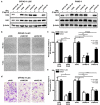Hexokinase 2 promotes tumor growth and metastasis by regulating lactate production in pancreatic cancer
- PMID: 28915575
- PMCID: PMC5593546
- DOI: 10.18632/oncotarget.9760
Hexokinase 2 promotes tumor growth and metastasis by regulating lactate production in pancreatic cancer
Abstract
Pancreatic ductal adenocarcinoma (PDAC) is a KRAS-driven cancer with a high incidence of metastasis and an overall poor prognosis. Previous work in a genetically engineered mouse model of PDAC showed glucose metabolism to be important for maintaining tumor growth. Multiple glycolytic enzymes, including hexokinase 2 (HK2), were upregulated in primary PDAC patient tumors, supporting a role for glycolysis in promoting human disease. HK2 was most highly expressed in PDAC metastases, suggesting a link between HK2 and aggressive tumor biology. In support of this we found HK2 expression to be associated with shorter overall survival in PDAC patients undergoing curative surgery. Transient and stable knockdown of HK2 in primary PDAC cell lines decreased lactate production, anchorage independent growth (AIG) and invasion through a reconstituted matrix. Conversely, stable overexpression of HK2 increased lactate production, cell proliferation, AIG and invasion. Pharmacologic inhibition of lactate production reduced the HK2-driven increase in invasion while addition of extracellular lactate enhanced invasion, together providing a link between glycolytic activity and metastatic potential. Stable knockdown of HK2 decreased primary tumor growth in cell line xenografts and decreased incidence of lung metastasis after tail vein injection. Gene expression analysis of tumors with decreased HK2 expression showed alterations in VEGF-A signaling, a pathway important for angiogenesis and metastasis, consistent with a requirement of HK2 in promoting metastasis. Overall our data provides strong evidence for the role of HK2 in promoting PDAC disease progression, suggesting that direct inhibition of HK2 may be a promising approach in the clinic.
Keywords: glycolysis; hexokinase 2; metastasis; pancreatic cancer.
Conflict of interest statement
CONFLICTS OF INTEREST The authors declare no conflict of interest.
Figures






References
-
- Howlader N, Noone A, Krapcho M, Garshell J, Neyman N, Altekruse S, Kosary C, Yu M, Ruhl J, Tatalovich Z, Cho H, Mariotto A, Lewis D, et al. SEER cancer statistics review, 1975-2010. Based on November 2012 SEER data submission, posted to the SEER web site. 2013
-
- Ryan DP, Hong TS, Bardeesy N. Pancreatic adenocarcinoma. New England Journal of Medicine. 2014;371:1039–1049. - PubMed
-
- Yeh JJ, Der CJ. Targeting signal transduction in pancreatic cancer treatment. Expert Opinion on Therapeutic Targets. 2007;11:673–694. - PubMed
Grants and funding
LinkOut - more resources
Full Text Sources
Other Literature Sources
Research Materials
Miscellaneous

